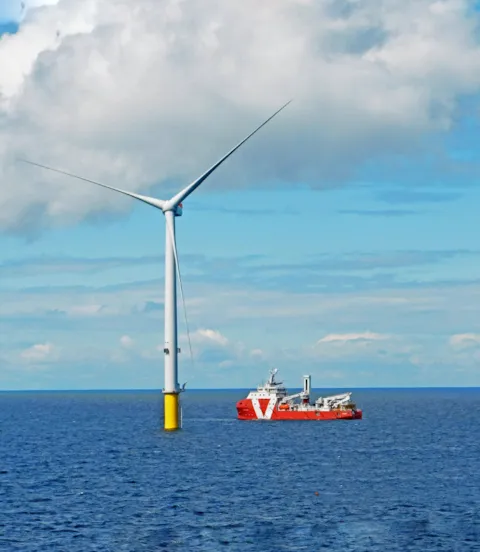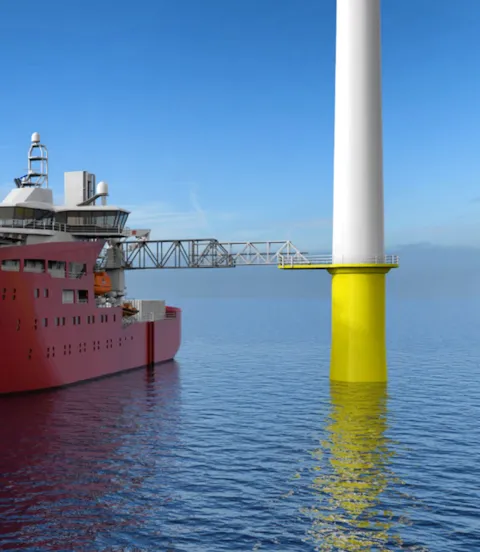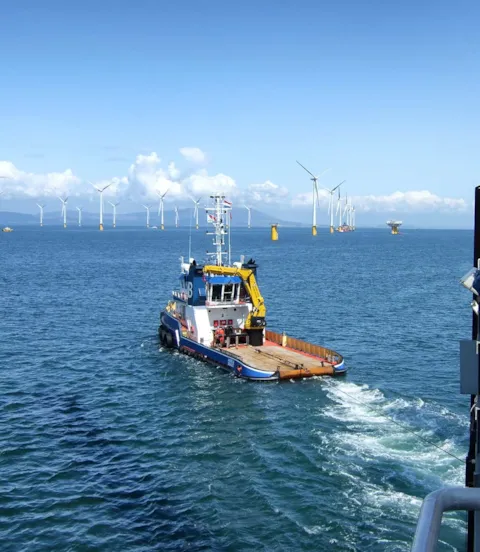Ensuring safer and more predictable DP operations
The safety of people and equipment when performing installation and maintenance of offshore wind farms depends on reliable dynamic positioning (DP) operations. DNV’s DP capability assessment standard and software play a key role in designing ships that can meet expected operational requirements efficiently and show the actual limitations for safe operation.
The ship designers at VARD are experts at developing highly sophisticated, specialized vessels, in particular service operation vessels (SOV) with DP station-keeping capability – ships that must maintain a specific position accurately in challenging environmental conditions. Designing or “right-sizing” these ships precisely for the expected conditions and knowing the safe boundaries for deployments to maximize efficiency, feasibility and safety is a science of its own.

Mitigating risks in offshore wind farm maintenance
As the world redoubles its efforts to decarbonize its energy supplies, the next wave of major offshore wind farm projects is fast approaching. The demand for wind farm installation and maintenance vessels is soaring, keeping designers like VARD busy.
When planning a service mission, key parameters for assessing the risk include the sea state, wind conditions, ocean currents, the design and DP capabilities of the vessel, its hydrodynamic characteristics and the power of its thrusters. To avoid unnecessary costs, failed attempts or even accidents, SOV operators need to be able to predict as precisely as possible whether a given vessel will be able to carry out the intended operation within the desired time window and weather forecast. This is a highly complex task.

Right-sizing offshore service vessels
“In the past, DP vessels were often oversized for good measure. But that is no longer feasible. An oversized vessel may sit idle a lot of the time because it too expensive to operate and consumes more fuel then needed during operations,” explains Niels Henrik Devold, Senior Engineer Hydrodynamics at VARD, a specialist in SOV design and newbuilds. “For ships to be competitive, it is important to optimize them for the actual environmental conditions in which they will operate to avoid excessive emissions and fuel costs.”
“We use the DNV ST-0111 standard and DNV’s DP station-keeping capability analysis software at VARD for designing ships with DP capabilities to define the requirements and dimensions of their propulsion systems and other performance characteristics. This helps us get the design better prepared to handle the actual reality,” Devold continues. “More and more of our clients ask us to base our designs on the DNV standard. While most other software products are based on simplified models and conditions to some extent, the DNV application can account for the full effect of the environmental conditions.”

Charterers welcome trustworthy calculations
Right-sizing the design based on solid data will ensure that the ship will become more energy efficient in operation. “When a ship’s actual performance limitations are documented, they can be communicated clearly,” Arnstein Eknes, Segment Director for Special Ships at DNV, points out. “Charterers appreciate this documented clarity. It means that the SOV owners know exactly what they can promise to the charterers.”
“DNV’s DP capability assessment software and service not only help to specify the performance characteristics of a newbuild precisely to meet the expected requirements. The software also supports operators in selecting the right ship for every mission, location and environmental conditions,” adds Luca Pivano, Principal Specialist DP Simulations at DNV.

A standard and a tool for station-keeping analysis
DNV’s DP station-keeping capability analysis services and software have delivered crucial support to vessel and platform operators as well as ship designers for a number of years. They are based on the DNV standard for DP capability assessments, DNV-ST-0111, last amended in December 2021, which calls for a reliable tool to assess the DP capability of a vessel.
DNV’s DP capability assessment application fulfils this requirement. It can be accessed as a browser-based web app on the DNV Veracity platform. There is a free Starter version as well as a Basic and a Premium subscription version. All versions cover Level 1 assessments according to the standard and the Premium version also includes Level 2 calculations. Level 3 calculations for dynamic and time-based simulations can be requested from DNV as a service. “An increasing number of companies reference our standard for DP operated assets, both within the traditional offshore industry and within offshore wind. We see that our clients value not only the way DNV can support on this topic, but also DNV’s independent third-party role,” explains Odd Charles Hestnes, Head of Control Systems and Cybernetics Advisory at DNV.

DNV-ST-0111 standard establishes the operating limitations for safe operation
The DNV-ST-0111 standard has become an essential tool for the designers at VARD, says Devold: “We rely strictly on the standard, which allows us to compare designs like an apple to an apple. It is reliable – we don’t have to make all the decisions or figure out all the thruster efficiency ourselves and fight for our arguments. We can clearly see that this is the thrust loss; this is the effective thrust; this is the amount of energy we save; this is the maximum limit. We don’t have to spend our valuable time on defining the environmental forces. We rely on the standard and base our design on it. It helps us compete!”
Helping customers compete successfully is what DNV is all about, says Eknes: “We specialize in handling the complex relationships between the individual parameters influencing the outcome. We also have more advanced tools and capabilities on hand to calculate and simulate operations, not only before but also during deployment,” he stresses.
One important offshore operation is the “Walk to Work” (W2W) operation for transferring personnel to and from wind turbines and other platforms, which is an attractive alternative to personnel transfer by helicopter, basket or direct boat landing, especially in difficult wind and sea conditions. However, it heavily depends on advanced dynamic positioning technology to keep the boat steady so the movements of the gangway can be minimized for the technicians to step onto the offshore facility or escape from it safely. “This is a complex operation that has to be seen as a whole, rather than looking at the components individually, such as the vessel, the gangway, the receiving platform and the environmental conditions,” Hestnes explains.

Using the DNV application to plan operations
Ship or rig owners can use the software and its simulation features to plan operations. DNV’s software application can tell them whether the weather scenario that has been forecast for the next few days will allow the ship to stay in position next to its destination and “You can use the app to find a suitable time window for the deployment of the gangway for maintenance personnel,” says Hestnes.
Eknes further explains: “One of the key uses of these analyses is to validate that a ship is capable to do a job and that you have established the boundaries for safe execution.” This is essential for the contractual relationship with the charterer, Eknes points out. “When a mission has to be cancelled to avoid putting people and equipment in danger, the computation results from the DNV app can serve as evidence that the safe limits of the vessel would have been exceeded. This protects the ship operator against being pressured to perform unsafe work or incurring contractual penalties for non-performance. It creates a transparent benchmark for the feasibility of planned deployments, thereby strengthening the position of the ship operator.” Furthermore, when the DNV tool shows several safe windows for a planned operation, the software can also be used to estimate the most cost-effective and flexible one.

DNV’s Expert support gets the maximum benefit out of the application
“DNV has done solid work we at VARD can rely on,” emphasizes Devold. “We trust DNV – that’s how we start. We use the tool from the moment we begin looking at the stability requirements and from the first calculation through all iterations. This optimization process allows us to offer the customer a competitive price for the ship and the greatest value for money. VARD has a reputation to maintain and needs to deliver ships that are optimized for purpose,” adds Devold on the importance of thorough, dynamic modelling. “We are also aware of limitations of static methods applied for capability calculations,” Devold continues. “We find the ST-0111 standard and tools to be the best solution for designing a vessel for a given capability requirement.” The Level 1 and Level 2 methods of DNV-ST-0111, however, are based on static force balance to estimate the DP position keeping. “In real life, there are dynamic effects and behaviours,” which can be more precisely quantified with Level 3 analyses. “VARD always applies an additional margin to account for these effects, as power requirements might suddenly change during DP operations. To make sure our design can perform in the field as intended, we additionally use DNV’s dynamic capability analyses for power and thrust utilization control.
DNV has always been approachable to help its customers get the most meaningful information from the dynamic capability assessment software, Devold recalls: “Using the tool is relatively easy, but when we do have a problem, we just send an email to DNV, and we get a response quickly. The collaboration is very easy for us.”

Digitalization adds value to DP operations
As the development at DNV continues, new enhancements are integrated into the dynamic capability assessment and simulation software, says DP simulation specialist Luca Pivano: “In addition to other improvements, the December 2021 update of the web application included a thrust ventilation loss calculation formula as a major enhancement, which produces more realistic loss values for a thruster close to the water surface. We are planning to start piloting the next update soon including Level 3 features. It will add full dynamic time-domain simulation functionality for estimating the actual vessel positioning footprint.”
Digital tools like DP Capability and other DNV software advance the digital journey towards centralized information management, his colleague Eknes concludes: “Digitalization adds substantial value to DP operations in challenging environments.”
- Shutterstock / Ballygally View Images
- VARD
- Simon Mockler
- DNV
- Thomas Boehme